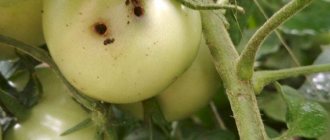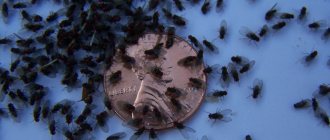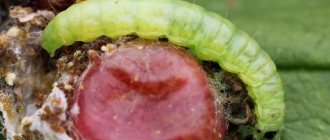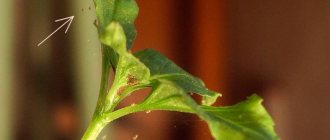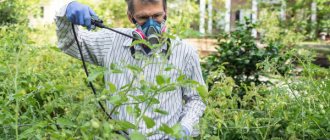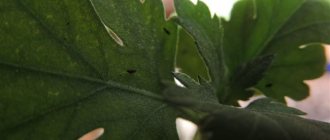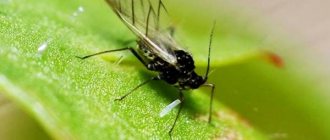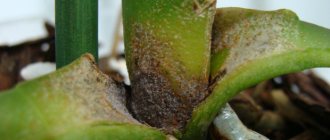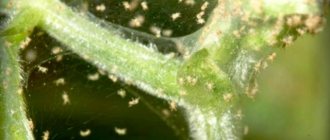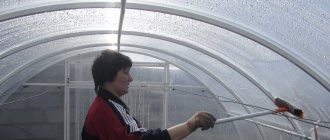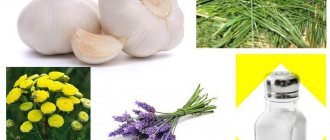Like all other plants, conifers are susceptible to diseases and pest attacks. In addition to viruses and infections, needle trees and shrubs on the site suffer from frostbite and sunburn of the bark, frequent contact with the urine of stray animals has a detrimental effect on crops, and if the winter shelter is not removed in time, the needles of conifers may rot.
Various types of aphids, false scale insects, scale insects, caterpillars, mites, diseases caused by primitive fungi - all this can be found on conifers. They also have their own specific diseases, most of which, unfortunately, can be transmitted not only between conifers, but also between deciduous plants. Prevention is the free placement of plants in the composition and the prevention of the spread of diseases to neighboring species.
The spread of old and the emergence of new pests and diseases of coniferous trees is largely due to the uncontrolled supply of imported material. When purchasing plants, never choose dubious specimens. Plant new plants for at least one year in an isolated “quarantine” area, and not in the general composition.
You will learn how and how to treat coniferous trees on this page.
Coniferous spider mite: why it is dangerous
The coniferous spider mite, as well as its larvae, feed on the juices of coniferous plants during their life. This destroys the cells of the needles, as a result of which its area becomes insufficient for photosynthesis and it turns white, dries and falls off. In addition, spider mites are carriers of various bacterial and viral diseases, which also negatively affect the appearance and condition of the plant.
However, the main danger posed by the coniferous spider mite lies in its fertility and speed of development. Under favorable conditions, it completely completes its life cycle (from egg to egg) in just 7-10 days, which can be considered a kind of record among pests. Thus, in just one season, just a dozen insects can turn into a colony of thousands, which literally occupies several dozen trees.
Pests of coniferous trees
Sawflies in the photo
Sawflies often eat the needles of pine and spruce trees. The most common are the common and red sawflies.
Common spruce sawfly in the photo
The common spruce sawfly in the southern region develops in two generations. In April - May, the larvae often completely eat the needles. At the end of June, pests of coniferous trees that have finished feeding on spruce branches make dense cocoons in which they pupate. After 2-3 weeks, second generation sawflies appear and destroy young needles. They overwinter in the soil or in coniferous litter.
Red sawfly in the photo
The red pine sawfly develops in one generation. It causes damage from the beginning of May, feeding on pine needles and sometimes the bark of young shoots. In August, it lays eggs inside the needles of young pine shoots, where it overwinters.
Green larvae (false caterpillars) of the sawfly in the photo
Green larvae (false caterpillars) of the sawfly , which harms juniper, have 3 dark stripes on the body and a brown head. They damage needles and shoots, eating away internal tissues.
Eating pine needles by larvae reduces the growth of pine trees; weakened trees are colonized by other pests (bark beetles and borers), specialized species that feed on various coniferous species.
Spider mite in the photo
Spider mite . This pest on coniferous plants is clearly visible in the morning dew. A thin cobweb covers young shoots in groups. The smallest mites (0.3-0.5 mm) move along this web. The sap is sucked out and the needles turn brown. The pest is especially dangerous in dry, hot summers, when it can produce up to 8 generations.
These pests of coniferous plants can also cause premature needle drop.
Adult insects overwinter under bark scales and at the base of needles growing in bunches.
If the needles at the top of the shoots of junipers are enlarged, then this is a sign of damage by the juniper needle mite. Conifers should be treated for pests when the first signs of damage appear.
Pine bug . Bugs found on trees are yellowish or reddish-brown, similar in color to pine bark. Their size is from 3 to 5 mm. Bugs and their larvae overwinter in the litter and under the peeling bark at the base of the trunk. In the spring, they crawl out of their wintering places and suck the sap from the trunk and shoots of pine trees.
Pests disrupt the conducting system of plants, which causes yellowing of the needles, decreased growth and general weakening of the tree. When severe damage occurs on young pines, dry tops, bent trunks, and sometimes the death of the tree are formed.
Aphids in the photo
Aphid . For spruce trees, infestation with this pest is very dangerous. This sucking insect, only 1-2 mm in size, is green in color, so it is difficult to see on the needles. Aphids cause yellowing and falling of needles, often massively.
It is important to detect the pest on twigs and needles as early as possible and carry out a series of insecticide sprayings at intervals of one and a half to two weeks until the aphids are completely destroyed.
You can detect the pest by shaking the twigs over a white sheet of paper. The development of aphids is noted already in May with the appearance of young needles.
Juniper aphids are found on young juniper shoots. During mass reproduction, young plants can be severely damaged by this pest: growth is delayed, shoots become bent and twisted. Spraying is carried out in the spring, as soon as the pest appears.
Pine aphid in the photo
Pine aphids are grayish in color, highly hairy, and have an oblong shape. Its rows are easy to notice on the needles of Scots or mountain pine. Spraying with insecticides is carried out in April - May.
Mealybug in the photo
Mealybug (hermes). This small (up to 4 mm) sucking insect, similar to an aphid, poses a certain danger to coniferous plants. The body of the pest is oval-shaped, yellowish, densely covered with white waxy secretions. In summer, sticky white patches of “cotton wool” form on the needles and young shoots.
This white fluffy coating on the needles of trees and shrubs indicates the presence of Hermes aphids. As a result of feeding on scale insects, the needles turn yellow and fall off. With severe damage, the death of young trees is possible.
Winged individuals of spruce-fir Hermes in the photo
Winged individuals of the spruce-fir hermes cause curvature of the needles in the feeding areas of aphids and their yellowing. At the buds, adult females appear on the bark, and brown or yellowish-green larvae appear on the needles. Spraying with insecticides is carried out in the spring when signs of pest infestation appear.
Adult larvae of scales overwinter on the bark of branches and trunks under scales and in cracks. Several generations are produced per year.
During the winter, many mealybugs die, and therefore there are few of them in the spring. The number of the pest gradually increases over the summer period.
The most dangerous are the juniper mealybug, as well as the mealybug that develops on larch.
Shield in the photo
Shield . Arborvitae and junipers, less commonly spruce trees, suffer from scale insects. Pest infestation begins from the middle of the crown. Small, shiny, brown scutes cling to the base of the shoots. The needles turn brown and fall off. The new generation of scale insects in the southern region hatches at the end of May and colonizes young growths.
On young cones and needles you can see the rounded scutes of female juniper scale insects or the elongated scutes of males up to 1-1.5 mm in size. These pests cause the bark to die, shoots to dry out and bend, and annual growth to decrease. They affect yew, juniper, thuja, and cypress.
Pine scale insects cause harm in a similar way. Scale insects are hidden under the needles, and therefore are difficult to destroy.
False shield in the photo
The false scale insect is also very dangerous for conifers. It colonizes twigs and needles. This pest is sprayed with Fufanon or Iskra Double Effect. Spraying of conifers against scale insects and false scale insects is carried out in the spring before the buds open.
Treatments are repeated in the first half of June with an interval of 8-10 days, alternating these drugs with “Zubr” or “Alatar”.
Caterpillars of the juniper shoot moth in the photo
Caterpillars of the juniper shoot moth eat away the insides of the shoots and severely damage various forms of common juniper. When these coniferous pests are detected, spider nests are collected and sprayed with pesticides to combat them.
The pine shoot is a small butterfly; Caterpillars harm by gnawing buds, as a result, panicles of needles with resin are formed at the ends of the shoots.
The tar shooter is a small butterfly; Caterpillars cause damage by gnawing into the bark and forming resinous galls that increase in size. Shoots above the galls become bent and dry out.
The pine silkworm is a butterfly with a wingspan of up to 7 cm. Its caterpillars pose a danger to coniferous plants. They are brown-gray and reach 7 cm in length. Caterpillars begin to emerge from eggs before bud break and continue to hatch until mid-June; within two months they eat needles and pupate. Butterflies fly out in August and lay eggs (200-600 eggs each). The pest overwinters in the egg stage.
Less often, needles are damaged by moth caterpillars, and cones suffer from tar and moth. When growing pine seedlings, plant death can be caused by May beetles. Both beetles cause damage by eating the needles, and larvae damage the roots.
Watering conifers
When the temperature outside the window is above 0°C for several days, the snow begins to melt and the spring sun becomes a frequent guest in the garden, it is necessary to reduce the risk of drying out the needles, because under the influence of direct rays moisture begins to evaporate from it. Due to the fact that the ground is still frozen, plants have nowhere to take water supplies. The needles and shoots can dry out, increasing the risk of death of the entire seedling. To prevent this, it is necessary to irrigate the needles. To do this, you need to arm yourself with a spray bottle (a simple one is enough) and pour water at room temperature into it. It is recommended to spray the crowns of plants on a cloudy, windless day. Using these recommendations, you will restore the water balance of your plants. And remember that irrigating the shoots is mandatory for dry areas. If in your region there is an abundance of rain, snow, and even groundwater lies close to the surface of the earth, then this may not be done.
Spruce pests: external features, signs of appearance
“The whole creation groans and suffers” from disease. Humanity has been observing this simple truth for about 6 thousand years. How sad it is when majestic coniferous trees or shrubs gradually dry up, turning into lifeless idols. Often the reason for this outcome is the spruce pests that settle on it. However, if you intervene in time, the tree can be saved, extending its life for decades.
To begin with, it is important to get to know the parasites better in order to be the first to deal the fatal blow. In nature, there are 3 main types of spruce pests:
- sucking;
- pine-eaters;
- stem.
Each of them has its own distinctive features, which are important to know well. This will help to detect pests as early as possible and begin elimination.
Description of the spider mite
Biologists note the very small size of the insect, 0.2-1 mm, so that it is almost impossible to see it without a magnifying glass. The color of the tick is light green, red or yellow, depending on the type of this arachnid creature. Females are capable of laying 7 eggs per day, placing them on the fleecy side of the leaves. In winter, the female hides the clutch in the bark of a tree or in fallen leaves.
The most common type of tick in Russia: the common one, which eats many plants, from garden to indoor ones. Another name for this pest is berry, strawberry or strawberry pest.
The spider mite got its name because it weaves webs on green spaces.
Interesting! There is one ornamental plant - castor bean, the seeds of which look like small ticks. These seeds are very poisonous and dangerous to humans.
Plane beetles, or false spider mites, are often confused with spider mites. Their sizes are exactly the same, but they do not weave webs. They, unlike their relatives, love high humidity.
Main diseases of ornamental conifers
The tips of the needles begin to turn yellow for various reasons. In the spring, the bright sun causes burns and a bronze appearance appears. Common infections include fungal infections. Rust appears more often on pine, and juniper is affected. From swellings that appear on the branches, spores are transferred to currants and pears. Fusarium, cytosporosis, and phomosis are considered dangerous diseases. Thuja suffers from them. Defects appear on the bark and branches. The needles darken and fall off.
Old, unkempt trees are susceptible to diseases. There are breeds of conifers that are resistant to fungal diseases. But they are not immune from caterpillar attacks. There is only one conclusion: if you plant evergreen forest wonders on your site, study ways to combat infections and pests.
Prevention of diseases of coniferous plants
As doctors often tell us, any disease is easier to prevent than to treat. This message applies to all living things and to conifers, including. Therefore, prevention cannot be neglected. And it begins from the moment of choosing a seedling.
Preventive measures that are necessary for coniferous plants:
- When purchasing a seedling (it doesn’t matter if you buy it in a store, at a market, in a nursery, or dig it up in the forest), first of all, you need to assess the condition of the needles and branches. The shoots and trunk should not have damaged bark or streaks of resin, and the needles simply must be clean - without dried or yellowed areas, without plaque or stains. If a plant is bought on sale - with obvious defects, but cheap - it will require treatment and quarantine. Such a specimen cannot be immediately planted with healthy plants.
- Even if you brought a seemingly healthy seedling into your garden, spray it with a fungicide before planting for prevention. The fact is that many diseases have a long incubation period and the disease does not manifest itself immediately.
- Inspect your young conifers regularly. This is the only way to detect signs of disease or emerging pests in time. After all, the sooner the problem is detected, the easier it is to deal with it, and the greater the chance of the plant not dying.
- Healthy, well-groomed trees are less susceptible to attacks from all kinds of diseases and pests and can more easily cope with such troubles. Therefore, proper planting and care play a crucial role in disease prevention.
Mandatory, but simple care activities that you can do to give your conifers health:
- timely watering;
- applying seasonally appropriate root and foliar fertilizers;
- removing broken or damaged branches;
- mulching;
- preparation for wintering.
Read about the rules for preparing coniferous plants for winter in the article “7 conditions for successful wintering of coniferous plants.”
Caring for conifers in spring
Also, in order to reduce the degree of desiccation and avoid burns of conifers in the spring, you can take care of the plants in the fall. Moisture-recharging watering of coniferous and deciduous plants will help with this. We have already discussed in detail the basics of moisture-recharging irrigation and you can familiarize yourself with its principles in our article “Important work in the garden in the fall for the safe wintering of plants
When spring finally comes into its own and the threat of the “dangerous” sun has passed, all shelters and strings (if any) need to be removed. After this, carefully inspect the plants for damage. Be sure to clean the needles - remove all dry needles that have accumulated during wintering. And remember that cleaning pine needles is an important preventative measure that must be carried out in the fall and spring. If you clean out the bulk of the needles in the fall, then in the spring this process will take much less time. And besides, cleaning pine needles in the fall will deprive any harmful insects and fungal diseases of the chance of survival.
Causes and measures to protect against yellowing of conifers
There may be several reasons for this phenomenon.
a) The first reason is lack of moisture. IN SPRING it is frozen ground. The branches wake up earlier than the root system, which is still asleep and cannot supply moisture to the more numerous branches and shoots. If the soil in the tree trunk circles has not thawed, then at the end of February - mid-March (depending on the region) you need to add water to the soil. Moisture will instantly become available to saturate the branches.
Abundant watering is necessary for conifers in the AUTUMN. If, having been left without moisture in the fall, the conifer went into the winter poorly prepared, then with the arrival of warmth it is difficult for it to immediately begin to grow and ensure moisture exchange.
Abundant watering and sanitary sampling of conifers
b) The second reason is sunburn. Remains of snow located on the crown of conifers reflect the bright spring sun, and burning occurs. Most often this is observed in a long spring, accompanied by thaws and sharp frosts.
A protective measure is the installation of screens. To do this, use a wooden frame and a covering agricultural material attached to it. The danger of such burning may not be immediately replaced, since the branches may be green, but dried out. The needles and twigs become inelastic and fragile. Yellowing will come later.
Screens also protect the bark and wood of the trunk and skeletal branches.
Examples of protective shelters/screens for conifers
c) Natural yellowing of the crown. Conifers are called evergreen not because of the endless life of their greenery, but because of its subtle replacement. The lifespan of green needles depends on the type and variety of the plant and is measured at 3–6 years. Then the needles lose strength, elasticity and color, after which they fall off, giving way to new ones. In this case, the yellowing of the thuja goes from the trunk and skeletal branches to the outer part of the crown; it is hardly noticeable and not critical.
If the thuja turns yellow for natural reasons, no special measures are taken. With the arrival of warmth, the plant will wake up and regain its attractive appearance. In this case, sanitary pruning of conifers and the application of nitrogen fertilizers will help.
d) External factors. They have a place for conifers growing along fences and paths. These include reagents designed to accelerate the melting of snow and ice, intense car exhaust, aggressive compounds and heavy metal salts entering the soil with melt water, systematic excrement and markings of pets (cats and dogs). The protective measure is the same - sanitary pruning of conifers and application of nitrogen fertilizers.
e) Poor rooting of young plants due to the wrong choice of place for planting conifers (see below for choosing a place for planting conifers).
f) Damage to conifers by insect pests and diseases (see below, damage to conifers by diseases and insect pests)
For what
To do everything correctly, you need to understand why processing of conifers is necessary:
- wake up from winter sleep and activate growth;
- facilitate planting, reduce stress, increase survival rate and resistance to external negative factors;
- improve decorative properties, make the needles even brighter and more beautiful so that they do not fall off;
- protect from too intense rays - help avoid sunburn;
- reduce the risk of disease and exposure to pests - as a preventive measure;
- cure a disease;
- eliminate insect pests.
At each stage of development of a coniferous plant, general strengthening, preventive or therapeutic treatment is carried out. It allows you to keep the tree healthy and helps it cope with various diseases, pests and unfavorable external conditions.
Why is it dangerous for plants?
Since this insect sucks the juice from the leaves, this leads to the gradual death of some tissue. Numerous “dead zones” form a drying area, resulting in leaves falling off. And without foliage, the plant cannot feed and develop, so it dies.
In addition to this main reason why ticks are dangerous, there are several more:
- it carries viral and fungal diseases;
- spreads gray mold spores;
- makes the plant vulnerable to disease.
Before the insects have time to multiply exponentially, it is immediately necessary to apply various methods of combating larvae, eggs and adults of spider mites.
Non-infectious diseases of coniferous plants and elimination measures
Burn. Solar radiation is especially dangerous for young trees. Snow cover reflects rays and increases moisture evaporation. Roots in frozen soil are unable to compensate for losses. Sap flow begins when the soil warms up to +4°C; up to this temperature the roots are dormant. Young conifers planted in the fall can die from burns. My young pine tree died; we didn’t cover it for the winter. I noticed that glare from greenhouses, house windows, and shiny roofs act like mirrors. If brown or yellowish spots appear on the crown, you need to look for where the bright light is coming from.
Measures to protect against the spring sun:
- Young trees are helped by spraying - the branches are generously moistened with a sprayer or garden sprayer.
- You can throw burlap or covering material over small trees in spring or autumn. It will protect from the scorching sun and drying wind.
- By scattering black soil or ash on the snow, they “start” the process of snow melting, and the roots begin to absorb moisture.
When planting trees, it is important to maintain the integrity of the root ball of earth. When seedlings are purchased in pots, they take root better. Pines are more resistant to transplantation; their needles grow back after rooting. The most capricious is the forest spruce. She usually gets sick for a long time; it is advisable to shade her in the spring for the first three years. Of the junipers, I recommend the varieties “Skyrocket” and “Bluealps” (Cossack).
Other reasons for yellowing needles:
- Mechanical injuries to trees occur due to snow load and damage by animals.
- An undeveloped root system is typical for weakened seedlings; it is better to immediately choose decent planting material.
- In case of strong return frosts with active snow melting, the bark cracks; it must be checked and the cracks must be covered with varnish.
- In flooded areas, stagnant water provokes the development of root rot and changes the acidity of the soil.
The resistance of conifers to non-infectious lesions is increased by bioactive drugs:
- Kornevin (stimulates the growth of the root system)
- Super humisol – a balanced mixture of trace elements and minerals;
- Zircon is a complex action drug;
- Siliplant is a silicon-containing chelate microfertilizer.
Timely feeding strengthens the immunity of plants, they are less susceptible to burns, and grow faster in the spring.
Causes of the parasite
How and where does the parasite get to the plant? There may be the following reasons for this:
- With an infected plant brought from a nursery or store.
Important! When purchasing a new flower, you should immediately examine your pet thoroughly. If there are white or yellow spots on the leaves, you should refuse to purchase.
Advice! Immediately place the new plant for 2 weeks in a separate place, away from other plants. If problems suddenly arise with mites or other insects, other plantings will not be affected.
- With purchased or street soil substrate, humus. Under unfavorable conditions, an insect can hibernate and not reveal itself in any way. At high temperatures and low humidity, the tick wakes up and becomes more active.
Advice! Before using such soil, it must be disinfected using hot temperatures, for example, calcination.
- With the wind, which carries ticks through the air. On an open balcony, the likelihood of picking up a parasite increases.
- With gardeners' clothes. Clinging to a shirt or trousers, an uninvited guest ends up in a garden, greenhouse, or house.
- From plants adjacent to the dacha plot already infected with mites.
Protecting conifers from pests: how to treat plants
To successfully grow conifers in a garden plot, maximum compliance with the conditions required by the nature of plants is necessary: a sunny place, fertilized soil, watering and mulching the tree trunks with peat or pine sawdust. You should not dig up the soil under the plants and rake out fallen pine needles.
When pests appear in the evening, to treat conifers against pests, spray with one of the insecticides (“Iskra Double Effect”, “Iskra Zolotaya” or “Senpai”, “Alatar”). Use Fufanon or Iskra-M against spider mites. The treatment must be carried out in the spring during the period of bud break, repeated at intervals of 10-12 days. Then carry out constant monitoring for possible resumption of pest development.
In the first half of summer, coniferous plants are fed with special complex mineral fertilizers. Plants respond well to fertilizers containing magnesium (“Kalimagnesia”, “Magnesium sulfate”, “Magbor”, etc.).
In the hottest months of summer (July - August), to protect conifers from pests, it is advisable to wash the needles with water from a hose in the evenings. Removing dust makes plants healthier.
Conifers on the site must be placed so that their crowns do not shade deciduous fruit trees, so that the ground under them is not trampled, and the wax coating on the needles is not subject to mechanical damage.
- Author: admin
Rate this article: (36 votes, average: 3.7 out of 5)
Schutte's disease
The most common disease, which is found everywhere, and therefore is especially dangerous in densely planted nurseries for growing coniferous trees, will, of course, be Schutte. This disease is typical only for coniferous tree species. Shutte begins in May with the browning of the needles. The next year, after the snow melts, you can easily see black, shiny, elongated dots on the infected needles, as if drawn with a marker. Then the needles are “glued together” with a gray web that darkens over time. The needles underneath become brown, but do not fall off.
This is a brown scute that affects spruce, pine, fir and juniper. The fungi that infect pines and junipers are different, and the shuttes themselves are different, but the outcome of the infection is always the same: thin branches die off after the needles fall off, the tree stops developing and eventually dies.
The main risk factors are planting density, high humidity and lack of nutrition for young shoots. The disease manifests itself especially violently on weakened sprouts, so preventive actions must be comprehensive, including not only the removal of fallen needles, immune feeding and fungicidal treatments, but also spraying with copper-containing preparations throughout the summer. For example, the drug “Chistotsvet” has already proven its effectiveness in the fight to reduce the development of Schutte, and “Horus” is also quite good.
For treatment, the root is watered with hydro solutions of “Fundazol” or “Kartotsida” once. After 4 days, you can use the biological products “Fitosporin” or “Alirin”. Solutions are prepared from them for watering and spraying throughout the spring-summer season (at least 4 times).
Treatment of conifers against pests and diseases with pesticides
It is recommended to spray plants with insecticidal and fungicidal solutions 2-3 times with intervals of 10 days. The drug is diluted with water according to the instructions. After the procedure, the tree is covered with plastic film, which is removed after half an hour. After 3 days, the wood is washed with running water. Do not treat coniferous pests in hot weather or before rain. The best time to spray is early in the morning. When carrying out the procedure, you need to wear safety glasses, gloves and a respirator.
Symptoms of plant damage
The following signs of mite damage to plants are distinguished:
- Brown spots that look like holes made with a needle.
- Yellow or light green dots.
- Falling flowers and leaves.
- Slow plant growth.
- Silvery webs between the leaves.
- The presence of small insects on the underside of foliage that look like red or yellow moving dots.
- A large number of mites on the web is a sign of a large mite infestation.
- The presence of black grains that are easily separated from the plant - mite excrement.
The spider parasite loves greenhouse crops with thick, fleshy leaves. Plants such as ficus, hibiscus, and fuchsia are most susceptible to its attacks.
Sheltering conifers for the winter
Outside the window, a snowy winter reigns, covering everything around with its white blanket. And regardless of whether you live in a country house all year round, or come only on weekends, it is recommended to periodically shake off piles of snow from the branches of coniferous trees to prevent them from breaking off. Plants that are too fragile, such as thujas, vertically growing junipers, cypresses and other coniferous crops need additional tying with twine to avoid breaking the crown.
Infectious diseases of coniferous plants: prevention and treatment
Fungal diseases on all crops are treated in approximately the same way; when prophylactically treating fruit and vegetable crops, we must treat the conifers with Bordeaux mixture. If the plant still gets sick, they resort to purchased drugs. It is important to correctly determine the cause of the lesion in order to determine which remedy to purchase.
I'll start with the winter disease Schutte; the fungus develops under the snow when the temperature is around 0 °C. Symptoms appear in spring or summer. According to the description, the disease is not similar to other fungal infections; it appears on needles:
- gray-black coating;
- small dots.
The needles darken or turn yellow and fall off.
Control measures:
- sulfur-lime decoction - 3 times per summer;
- With the preparations “Abiga-Pik” and “HOM” two treatments are enough.
Be sure to spill the soil to a depth of 5 cm.
Rust is similar to lesions on fruit trees. Traditional treatment methods: fungicides and copper-containing preparations.
Pine spinner is manifested by the curvature of the shoots. Yellow-orange swellings appear. For treatment you will need Fundazol; two treatments are enough.
Fusarium develops in the soil at the roots of pines, spruces, larch, and fir when it is too damp. The central part of the crown is crumbling.
Drainage is carried out, the use of “Fitosporin”, “Alirina” will help revive the trees, they will turn green again if the branches do not have time to completely dry out.
Alternaria blight is terrible for junipers and thujas growing in the shade. Blackish, dark gray spots spread across the needles. Affected branches are removed. To treat conifers, compositions with copper sulfate or celandine infusion are used. The fungus must be suppressed until late autumn.
Bacteriosis is characterized by paleness of the needles; they begin to crumble from a light touch. This disease has no cure. For prevention, treatment with Fitosporin is carried out.
Biatorella cancer is dangerous because it affects wood. When an infection occurs, the color of the young bark changes, it becomes brown, then cracks and dies. Long, elongated ulcers form and become covered with resinous fungal growths.
Gradually the tree dies, the needles turn yellow and fall off. Treatment requires triple treatment at intervals of 2 weeks. It is important to soak the soil well with the preparations.
Types of rust in conifers
The most common “uninvited guest” on pine and larch is fungal rust, caused by several types of fungi. When bushes and trees are affected, yellow-orange spots appear on their needles in early spring. Upon closer inspection, it is clear that the spots are formed by yellow vesicular pustules located randomly on both sides of the needles. After the mushroom releases its spores, its body darkens, becomes brownish-red in color, and the branches of the conifers look as if they are painted a rusty color.
Blister rust of pine or cedar looks somewhat different: it tends to attack the tree trunk and its branches. At the site of introduction of the fungus, the bark bursts, and spore carriers of a pale orange color become visible at the site of the rupture. The mushroom rings the branch in a circle and its upper part dies. If such ringing occurs under the crown, the tree will die.
For treatment, fungicides “Skor” “Topaz” and “Strobi” are used, which effectively clean conifers from these diseases and promote rapid healing of wounds caused by the fungus. To enhance the effect, you can and should add cartocide to the solution with the drug. These drugs complement each other perfectly and the result after their processing is truly stunning.
It should be noted that the spores of these fungi develop on weeds and then attack coniferous shrubs and trees, so removing weeds from a site is an excellent way to prevent these diseases.
Prevention can also be considered the timely pruning of not only diseased branches, but even those that cause you concern, even if you are not sure that the tree is infected. Try to create the most favorable conditions for the growth of young conifers:
- treat them with immunomodulators - growth regulators that increase the resistance of young seedlings to unfavorable stressful conditions during cultivation and care;
- apply fertilizers and top dressing specifically for coniferous trees in a timely manner, make sure that everyone has enough “place in the sun.”
“Super-humisol”, “Epin-extra”, “Siliplant” and “Nikfan” have proven themselves to be excellent for root and foliar feeding of conifers. For treatment, “Skor” or “Strobe” are used for three times spraying and watering at intervals of 2-3 weeks. The fungus, penetrating the wood, forms local foci and causes tissue necrosis. Coniferous plants are affected by several types of cancer:
- Biatorella is caused by the pathogen Biatorella difformis. Characterized by desiccation and cracking of the bark. Resin in which the pathogen lives is released from the crevices, and the crown turns yellow.
- The nectria type of the disease is manifested by the appearance on the surface of the trunk of rounded neoplasms with a diameter of 3 mm, having a brick tint. Later, the growths darken and the top of the plant turns yellow. The disease is caused by the fungus Nectria cucurbitula.
During treatment, the affected branches are cut off and covered with oil paint or garden varnish. Next, spraying and watering with “Kartotsid” is carried out up to 4 times.
Disguised "infiltrators"
In addition to external enemies of coniferous trees, there are stem pests of spruce. They penetrate the bark of young seedlings, destroying the tree from the inside. The topographer bark beetle settles in the trunk of a coniferous tree. It releases an aromatic substance that attracts insects within a radius of 11 km. This is the main sign of the pest. Plant damage manifests itself in slow growth of shoots and massive falling off of old needles. Dried branches usually remain on the tree, as a result it loses its decorative effect.
The beetle must be destroyed before the offspring are born.
Dangerous stem pests of spruce trees are large pine beetles and black longhorned beetles, which make many passages inside the wood. As a result, the development of the plant is disrupted and it becomes sick.
Fungal diseases of conifers
The roots of conifers are also affected by fungi. These soil-dwelling fungi lead to a gradual reddening (and then browning) of the roots, after which the roots die, and the plants die along with them. The fungus that has infected the roots also penetrates the vascular system of the tree, filling the wood with its biomass, blocking access to nutrients. The cut clearly shows the darkening of the ring of the core and xylem, the needles turn yellow and fall off, the tree or bush dries out.
This disease - fusarium drying out or root rot - almost always occurs in a hidden form, you may not suspect anything until the crown of your thuja or pine tree turns yellow and becomes “transparent”. Unfortunately, it is almost impossible to treat such a disease, but you can prevent it. When transplanting to a permanent place, the seedling should be soaked for several hours in a solution of Fitosporin-M, Vitaros or Maxim.
If doubts arise after planting, as a form of prevention, you should generously shed the soil around the roots with the same “Fitosporin-M”, “Agata-25K”, “Gamair”, or you can use a fungicide that is on hand.
Mushrooms are also to blame for the development of pine pitch cancer, or a similar disease - pine cancer. But if the first mushroom develops initially on swamp bluegrass and impatiens, then the seryanka migrates from pine to pine. Infection occurs through the needles, twigs, and bark of young seedlings, from where the mycelium of the fungus spreads to the entire trunk. The affected area of the bark becomes dark gray in color, and the tree itself dies after 2-3 years. If gray spots are detected on the branches and trunks of conifers, you must immediately begin spraying with “Fitosporin” or “Abigapik” and cut off all branches affected by fungi.
Means to combat spider mites
In order to destroy or remove the pest, gardeners and gardeners use:
- chemical;
- biological;
- folk and mechanical remedies for spider mites.
Industrially produced drugs are the most effective if used correctly.
Chemicals
These products include insectoacaricides. In most cases, these drugs are used only in non-residential premises and require careful use.
Aktellik
Actellik is a good drug based on pirimiphos-methyl, which has a contact effect on the parasite. Through the impact on the intestines of insects, it leads to impaired digestion of food and the death of the pest.
Treatment is carried out 2 times with an interval of 2 weeks. In order to comply with safety precautions, you must wear a protective suit, otherwise toxic fumes will lead to poisoning.
It is used when processing vegetable gardens, greenhouses, grain storage barns, and storerooms. Effective against the parasite on cucumbers, tomatoes, sea buckthorn, etc.
Directions for use: dilute 2 ml of the substance in water per 2 liters of water, spraying the plants through a spray bottle. One ampoule is enough for 10 sq. m. planting cucumbers and tomatoes.
Apollo
Designed to destroy mites on fruit trees, grapes and berry crops. Effectively destroys eggs and small insects. It acts on adults only as a sterilizer, making females infertile. Contains the substance clofentezine.
Treatment with the drug is carried out at the time of swelling of the buds in early spring, spraying it on the bark and branches of bushes and trees. Strawberries are sprayed before flowers appear on the plant.
Demitan
A contact action product, effective on fruit crops: pear, apple, and grapes. Spraying is carried out with a solution of the product at a rate of 1 liter per 10 acres. Treatment is carried out before flowering.
Neoron
Works against all types of mites on garden, berry and fruit crops. Destroys insect nests and larvae. The active ingredient is bromopropylate. Due to the fact that it does not affect bees, it can be used during the flowering phase. Effective at any temperature. Consumption rate of the drug: from 0.8 to 2 liters depending on the area. Directions for use: dilute 1 ampoule of 12.5 ml per 8-10 liters of water and generously moisten the leaves and stems of plants.
Omite
The active substance is propargite. The effectiveness of the drug is at a temperature of 25°C. Does not destroy eggs, but destroys adult insects and larvae. It is used on open ground, melons, cherries, apples, plums, and lemongrass.
Directions for use: dilute 10-15 ml in 5 liters of water and spray the plants. For citrus fruits, the dosage is increased by 5 ml.
Fufanon
The active ingredient is malathion. Effective within 10-14 days after treatment. Dilute 5 ml of poison in 5 liters of water and spray the plants. Its effects are similar to domestic karbofos; treatment is carried out only in open, well-ventilated areas.
Anti-mite
Similar in composition to fufanon. Effectiveness lasts for 2 weeks. Directions for use: dilute 10 ml per 10 liters of water and spray:
- raspberries - 2 times 2 liters per 10 bushes;
- apple tree - from 2 to 10 times during the entire growing season, 2-4 liters per tree;
- cucumbers and tomatoes in a greenhouse - from 1 to 5 times throughout the entire gardening season, 1-3 liters per 10 acres.
Akarin (Agravertine)
Agent of contact-intestinal action. Made from Streptomyces, a fungus that lives in soil. Available in ampoules. Efficiency is achieved by treating crops two or five times:
- cucumbers, eggplant, sweet and bitter peppers - 2-8 ml/1l of water;
- cauliflower, white cabbage - 4 ml/1l of water;
- currants and other berry bushes - 2 ml of substance per 1 liter of water.
Bitoxibacillin
Effective against all types of this pest, both in open ground and in greenhouses. But if you plan to add Phytoseiulus, a predatory mite that eats spider mites, to your plants, this drug should not be used. Bitoxibacillin hazard class is 3, safe for bees and beneficial insects. This drug also helps against the Colorado potato beetle.
Fitoverm
Less harmful than the widely advertised Actellik, but its use also requires protective equipment: a respirator and gloves. The active ingredient is aversectin-S. It is often confused with phytosporin, although the latter is a very weak remedy for spider mites and rather helps to get rid of fungal diseases caused by insects.
Effective against settlers on currants and apple trees. Can be used shortly before harvest and during flowering.
Directions for use: dilute 1 ampoule of the drug in 1 liter of warm water and add water to 10 liters. Spray the plants:
- fruit and berry trees and shrubs 1.5 ml per 1 l;
- cucumbers, tomatoes, peppers, potatoes - 10 ml per 1 liter of water.
For greater effectiveness and adhesion of the solution, you need to dilute laundry or green soap in it.
How
In order for the treatment of coniferous plants to be effective and achieve maximum results, it must be carried out correctly. Sometimes even the most expensive product, which everyone praises, turns out to be completely useless only because it was applied without following certain rules. Before you go and spray plants, you need to learn how to do this.
First, you need to clearly understand the purpose of the processing. Why are you going to do it? As we have already found out, it can be preventive, therapeutic or restorative. In this regard, a specific drug is selected. When choosing it, rely on the advice of experts. It must solve two problems: help achieve results and be intended for external spraying of coniferous plants (not fruit, not flowering, not garden, but coniferous).
Secondly, you need to carefully study the instructions for the chosen drug. In terms of proportions and protective measures, it must be strictly observed. If biostimulants are most often produced on a natural basis and are completely harmless, then fungicides and insecticides can be quite dangerous to human and animal health - especially to the skin and lungs. Therefore, there must be extreme caution. Re-read the prescription of the drug. Not all of them have a wide spectrum of action. You won't be able to get rid of a bark beetle if the instructions say it's an aphid repellent.
Thirdly, you will need special equipment and clothing:
- protective glasses;
- protective face mask / respirator / multi-layer gauze bandage;
- thick gloves;
- rubber boots;
- special protective rubberized suit;
- headdress;
- a spray gun with nozzles / piston-type pump or compressor.
A spray container often comes complete with preparations for treatment, but not always. Its size depends on the height of the conifer. Ornamental varieties, ground cover plants, yew, juniper, small bushes can be sprayed with a regular spray bottle. For spruce, pine, cedar, cypress trees, alleys and hedges, more complex and voluminous structures are needed, and the jet of the sprayed product rises 2-3 m upward to spray the entire crown, and not just the bottom.
Fourthly, when processing you should try to follow the following recommendations:
- If it is possible not to mix two drugs (even if they are different in their functionality), do not do it.
- Dilute the product exclusively in the proportions specified in the instructions for it.
- Shake the spray bottle thoroughly several times before spraying.
- Conifers are processed at a distance of 0.5-1 m. Make sure that the jet reaches the tree (shrub).
- First, the trunk itself is processed from top to bottom, then the branches that make up the inner layer of the crown, and only lastly the outer needles.
- You should not miss a single area where fungal spores or insect eggs may remain.
- At the end of spraying, the root area with a radius of 1-1.5 m should be treated, because fungi and insects may also be present on it.
- The same applies to neighboring plants that are found very close to conifers.
- Upon completion of work, thoroughly rinse the spraying device.
- Wash your hands and face with antibacterial soap, take a shower, and rinse your mouth.
Fifthly, if there is a need for complex processing, when you need to mix two drugs and prepare one solution based on them, use the compatibility tables. Fungicides are designated by the letter “f”, insecticides by “i”.
